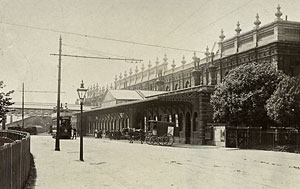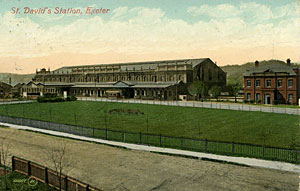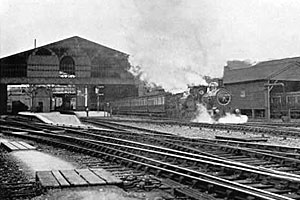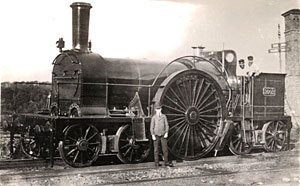
St David's Station
Page updated 11 November 2008
On the 7 January 1841 the Flying Post wrote "We understand the Directors of the Bristol and Exeter Railroad, intend making the terminus of this important undertaking in two fields adjacent to the Red Cow Turnpike." Thus the people of Exeter waited in anticipation for 'railway mania' to reach their city.
The site of the new station
The site for the station at Pennyroyal consisted of 18 acres of meadow, belonging to Mr W M Praed and farmed by Mrs Drew, dairywoman. It was chosen as the City Council refused permission for the line to enter the city boundary. The approach to the station required a second field, Taddyford Meadow, to be purchased, and the company approached the Master of the Worshipful Company of Tuckers and Shearers the owners to discuss the purchase of the meadow. Agreement was made, and now, the meadow lies somewhere beneath the multiple railway lines approaching the station. The local firm, Hoopers were engaged to construct the station to the design of Isambard Kingdom Brunel.
On 1 May 1844, the Bristol railway line finally reached the city and the Director's Special 'City of Exeter' steamed into the terminus after a journey of five hours from Paddington. A grand gala for 900 specially invited guests was held in the goods warehouse, with Brunel, the Mayor and other dignitaries in attendance. Two bands were present to entertain the guest, and there was a separate marquee for the ladies. Thousands of people swarmed around the station and the railway company provided a refreshment booth in the meadow for them. The Directors Special was not the first train to use the station, for at 7am on the same day the first scheduled service to Bristol and Bath left, and at 8.15am the first service to Paddington. In total there were seven dapartures that day, with the mail train the last to leave at 10.15pm for Paddington.
Serious consideration was given to naming the station Red Cow, but in the event, St David's Station was chosen. The platforms were both on the east of the track, thus preventing passengers from having to cross the line. Within days adverts were appearing in the Flying Post for horses and coaches for sale due to the 'extension of the Railroad'. The Telegraph coach and a four-horse harness was offered for sale in St Sidwell's, just nine days after the grand opening.
The South Devon Railway opens
On 30 May 1846 the South Devon Railway opened a line towards Plymouth, requiring a new carriage shed be built at the southern end of the station. Designed from the start to work on the atmospheric system, passengers had to change at St David's to continue their journey with a separate company. A pumping house for the atmospheric railway was built at the southern end of the station complex, and would remain until late in the 20th-century, although rebuilt as a water tower, as the atmospheric system only ran for 12 months. It was replaced by a modern signal box in 1985.
The Exeter and Crediton railway opened on 12 May 1851, as a branch from the line by Cowley Bridge, running into St David's. It wasn't until February 1862 that the Bristol and Exeter were forced to accommodate standard gauge alongside their broad gauge track, when the extension from the London and South Western Railway curved down from Queen Street Station, crossed Bonhay Road and entered St David's Station from the south.
Garibaldi drops by
Kelly's Directory noted that Giuseppe Garibaldi, the father of modern Italy passed through the station, on 25 May 1864 when he was 'received with great demonstration on the new platform by the citizens'.
A larger station
The London & South Western line had reached Northernhay's Queen Street Station in 1860, prompting the Bristol and Exeter to improve their facility at St David's. The present station, was opened on 1 June 1864 at a cost of £29,760 for the station and an additional £20,000 for other work. Designed by Francis Fox, it was dressed with Bath stone. A single span pitched roof, 360 ft by 132 ft covered the three tracks and platforms, making it the largest in the country. The main entrance façade had 26 ornamental urns along the top edge of the wall. By 1895 the station was handling between 12,500 and 22,000 passengers per month.
The station underwent enlargement and rebuilding in 1912-14 when Fox's 1864 roof was removed, and replaced with the present individual awning style roofing over the platforms at a cost of £33,325. Two through lines were added to the track layout, to accommodate the increase in traffic, making six through lines, five platforms and one bay line and platform. In July 1914, 28,755 passengers passed through the station. A makeover in 1938 added 11 ft to the width and the GWR logo at the front, and extra offices added to the main station block.
The Great Western Hotel probably dates from 1844, or just after. In 1876 it was known as the Railway Hotel and then in 1923, the Trust House Hotel. A hostel for refreshment room staff was built in the same style as the station master's house in 1938 at the bottom of St David's Hill, opposite the Jolly Porter; it is now the solicitors firm of Atkins Law.
Penguin Paperbacks
When Allen Lane, a director of Bodley Head found himself on the platform of Exeter St David's Station one evening in the early 1930's, after visiting Agatha Christie in Paignton, he tried to purchase a book for the rest of his journey. Browsing the bookstall, only magazines and Victorian novels could be found. It was then that he thought that there was a market for quality, but cheap books. Penguin paperbacks was the result, the first of which were sold in the summer of 1935.
The legacy of broad gauge, can still be observed when looking at the distance between the platforms at St David's, and the generous tunnel and bridge dimensions to accommodate the 7ft gauge, along the line. Brunel's railway shortened the London to Exeter journey time by stage coach in 1800 from 32½ hours, to 3 hours in 1900.
 St David's Station facade
with a waiting tram circa 1910.
St David's Station facade
with a waiting tram circa 1910. The green in
front of the station is now a car park. The red brick building on the
right was the station master's house.
The green in
front of the station is now a car park. The red brick building on the
right was the station master's house.
 The Cornishman
leaves St David's, circa 1900. Note the Fox designed roof over the
platforms.
The Cornishman
leaves St David's, circa 1900. Note the Fox designed roof over the
platforms.
 A Bristol and Exeter Railway 4-2-4T
in 1876 outside St David's engine shed.
A Bristol and Exeter Railway 4-2-4T
in 1876 outside St David's engine shed.
See St David's Station by Kent Rail for a fuller history.
│ Top of Page │